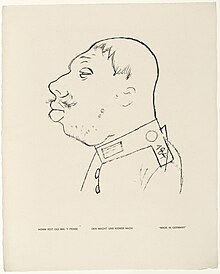
Back Neue Sachlichkeit (Kunst) ALS موضوعية جديدة Arabic Nova Objectivitat Catalan Nová věcnost Czech Neue Sachlichkeit Danish Neue Sachlichkeit (Kunst) German Νέα Αντικειμενικότητα Greek Nova Objektiveco Esperanto Nueva objetividad Spanish Uusasjalikkus Estonian

The New Objectivity (in German: Neue Sachlichkeit) was a movement in German art that arose during the 1920s as a reaction against expressionism. The term was coined by Gustav Friedrich Hartlaub, the director of the Kunsthalle in Mannheim, who used it as the title of an art exhibition staged in 1925 to showcase artists who were working in a post-expressionist spirit.[1] As these artists—who included Max Beckmann, Otto Dix, George Grosz, Christian Schad, Rudolf Schlichter and Jeanne Mammen—rejected the self-involvement and romantic longings of the expressionists, Weimar intellectuals in general made a call to arms for public collaboration, engagement, and rejection of romantic idealism.
Although principally describing a tendency in German painting, the term took a life of its own and came to characterize the attitude of public life in Weimar Germany as well as the art, literature, music, and architecture created to adapt to it. Rather than some goal of philosophical objectivity, it was meant to imply a turn towards practical engagement with the world—an all-business attitude, understood by Germans as intrinsically American.[1]
The movement essentially ended in 1933 with the end of the Weimar Republic and the beginning of the Nazi dictatorship.
© MMXXIII Rich X Search. We shall prevail. All rights reserved. Rich X Search